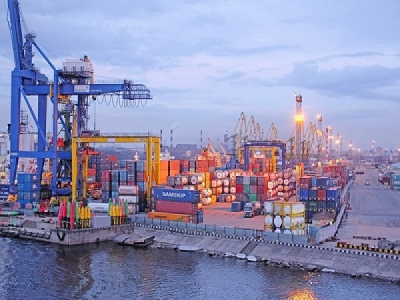
Posted on September 11, 2017
By Dag Pike, MJ
A considerable amount of dredging work is being carried out at the adjacent Russian ports of St.Petersburg and Ust-Luga using the fleet of dredgers operated by Rosmorport, the state port operator.
Much of this work is maintenance dredging but the work at Ust-Luga heralds the further development of this port to make it the major port in the Gulf of Finland.
Rosmorport has the trailing suction hopper dredger Kronshlot working at the Petrovsky fairway in the approaches to Big Port St. Petersburg and more than 29,000cbm of bottom material has been excavated and transported to the dumping ground. A further 5,000cbm of material remains to be excavated to maintain the depth of 11 metres in the channel and this is scheduled for completion by October.
In the northern access channel to the port of Ust-Luga the trailing suction hopper dredger Sommers is working with the non-self-propelled backhoe dredger Vaka Nami Go and hopper barge Fort at the mouth of the Luga River. Here more than 65,000cbm of material has been excavated and transported to the spoil ground and an additional 20,000cbm of material remains to be excavated by the end of October. This dredging will maintain the depth in the approach channel at 17.5 metres and the turning basin in the port is being expanded by 46 metres. The dredger Sommers is one of three sister ships that were built by Damen Shipyard in 2016 for Rosmorport.
The green light has been given to further expansion at Ust-Luga after extensive studies of the engineering and environmental factors of the expansion. The development of this port was one of the first examples of successful PPP projects in Russia when it was started in 1993. Today Ust-Luga is the largest and deepest port in the Baltic Sea, including the Baltic countries and Finland.
Currently, the port has 12 terminals that provide facilities for the handling and storage of more than 20 types of liquid, dry bulk, general and containerised cargo.
Under the proposed expansion the work will be executed in three phases. The first phase includes the formation of the water basin of the berths for the Multifunctional Transhipment Complex ‘Yug-2’ and the timber cargo handling facility. Phase 2 includes the formation of the water basin in the area of the shore protection of the southern part of the service/support fleet base and Phase 3 includes creation of the water basin for the remaining areas of the fleet base.
The project includes the dredging of a turning basin and access channel to ensure the safe manoeuvring and docking of ships at the berths and this dredging work is being scheduled so that it does not interrupt the port operations.
Source: MJ





